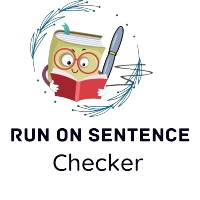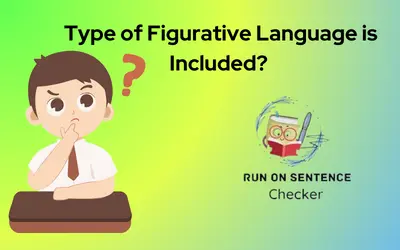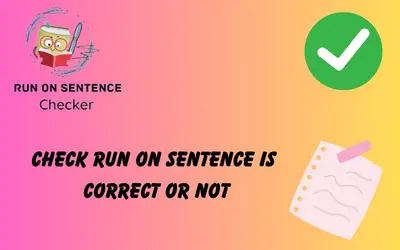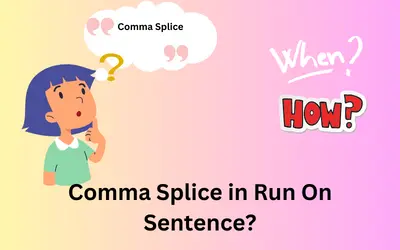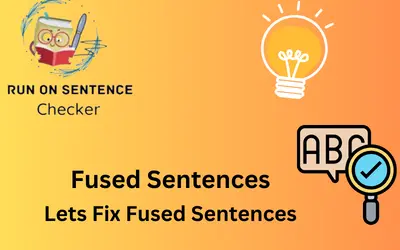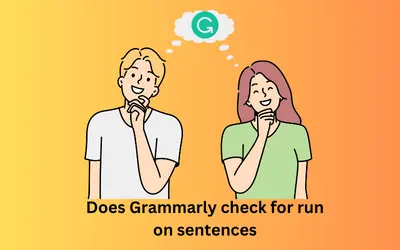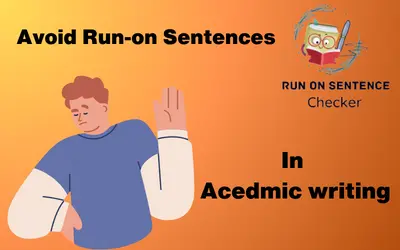In the world of grammar and punctuation, Comma Splice Different from a Run On Sentence are the distinction part in the crucial. These two common errors can significantly impact the clarity and coherence of your writing while writing comma splice sentence. Let’s delve into the nuances and explore ways to rectify and avoid these run-on sentence mistake.
What is a Comma Splice from Run On Sentence?
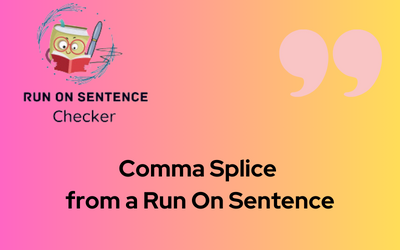
A comma splice occurs when two independent clauses are incorrectly joined by a comma without the appropriate conjunction. This results in a connection that, while grammatically incorrect, may appear deceptively coherent.
Consider the following example of Comma splice example:
“She loves hiking, he prefers cycling.”
In this instance, the comma attempts to bridge two distinct thoughts without the necessary conjunction, creating a comma splice.
The Mechanics of Run-On Sentences
On the other hand, Let find out what does a comma splice look like & fixing our run-on sentences checker and comma splice checker are compass a broader category of errors where two independent clauses are fused together without any punctuation or conjunction. They can take the form of fused sentences or, more specifically, comma splices.
Understanding the nuances of run-on sentences involves recognizing the varied ways in which independent clauses can be improperly conjoined.
Let’s take a closer look at what makes a run-on sentence a bit of a grammar hiccup. It’s like trying to fix a machine—first, we need to understand the parts and how they should fit together.
The Big Picture:
So, a run-on sentence is like a jigsaw puzzle missing some essential pieces. It happens when two independent clauses (you can think of them as complete thoughts) try to team up without the right tools—punctuation or a conjunction. It’s a bit like trying to connect two train cars without a coupling.
Fused Sentences and Comma Splices:
Now, there are two flavors of run-ons: fused sentences and, more specifically, comma splices.
Fused sentences are when two clauses collide with no punctuation at all. It’s like having two cars crashing into each other with no traffic signal.
Comma splices are a bit sneakier. They happen when you try to stick a tiny comma between two independent clauses, hoping it’ll do the job of a proper punctuation mark. It’s like using scotch tape to hold together parts that really need a solid weld.
Recognizing the Mix-Ups:
Understanding run-on sentences is like being a detective. You have to spot the clues, which are the ways independent clauses get improperly shushed together.
It could be a lack of punctuation altogether, or it might be that mischievous comma trying to play both sides. Once you notice these tricks, you’re on your way to fixing the sentence.
So, the next time you see two complete thoughts trying to team up without the proper gear, know that it’s a run-on sentence in disguise. Give them the right tools—some punctuation or a conjunction—to keep your writing engine running smoothly.
Comma Splice Different from a Run On Sentence Let Find Out Difference
Understanding the difference between a comma splice and a run-on sentence is a bit like recognizing different beats in a simple tune and you can expect the comma splice vs fused sentence. Let’s break down these grammar hiccups in everyday language.
The Confused Comma Splice:
Imagine you’re telling a story, and suddenly, you put a comma where a period should be. That’s a comma splice. It’s like having two separate sentences trying to hold hands with just a tiny comma, and it doesn’t really work in Comma Splice Different from a Run On Sentence.
Example:
“She loves hiking, he prefers cycling.”
See? The comma is trying to join two thoughts, but it’s a bit like trying to glue two puzzle pieces that don’t quite fit.
The Overlapping Run-On:
Now, picture another scenario. You’re talking, and you keep going without taking a breath or using any punctuation. That’s a run-on sentence. It’s like having a bunch of ideas in your head and tossing them all out without giving your reader a chance to catch their breath.
Example:
“She loves hiking he prefers cycling.”
Here, there’s no pause, no period, no comma—just a jumble of thoughts crashing into each other.
Spotting the Difference:
Okay, now let’s imagine fixing these issues is like giving our sentence a little makeover. For the comma splice, we might use a period or a connecting word like “and” or “but.” For the run-on, we’d do the same, making sure our thoughts have some space between them for Comma Splice Different from a Run On Sentence.
Example:
“She loves hiking. He prefers cycling.”
Now, each idea has its own space to shine, like giving each instrument in a band its moment.
The Wrap-Up Beat:
In the end, understanding the difference between a comma splice and a run-on sentence is like learning a simple song. It’s about giving your ideas the right space to be heard and making sure your punctuation is like the conductor, guiding each part of your story.
How to Correct Comma Splices and Run-Ons Sentence
Alright, let’s talk about how to untangle those tricky situations where commas try to play matchmaker, and sentences end up in a bit of a mess. It’s like being a grammar superhero—armed with the power of punctuation!
Know Your Punctuation Toolkit:
To fix comma splices and run-on sentences, you need to be familiar with a few punctuation tools. Think of them like superhero gadgets:
- Periods: The trusty full stop. It’s like telling your ideas, “Take a break. We’ll pick up again in a moment.”
- Semicolons: This is like a sophisticated pause. It says, “We’re related, but let’s keep a bit of space between us.”
- Conjunctions: These are your team players, like “and,” “but,” “or.” They connect ideas and keep the harmony.
Example in Action:
Let’s take a messy sentence and superhero-fix it:
Messy Sentence: “She loves hiking, he prefers cycling.”
Superhero Move: “She loves hiking, but he prefers cycling.”
See what we did there? We used the conjunction “but” to bring those independent clauses together in a way that makes sense.
Periods
Periods for a Breather is a concept that involves using periods, the punctuation mark “.”, to create a distinct pause or separation between two independent clauses or complete thoughts in a sentence. This practice is essential for maintaining clarity and readability in writing.
Sometimes, the best fix is a good old period. It gives each idea its own space to shine:
Messy Sentence: “She loves hiking he prefers cycling.”
Superhero Move: “She loves hiking. He prefers cycling.”
Now, they each get their moment in the spotlight.
The Semicolon Sophistication
The Semicolon Sophistication refers to the use of semicolons (;) in writing to add a touch of sophistication and clarity to the structure of sentences. Semicolons serve as a punctuation mark that indicates a pause that is more significant than a comma but less final than a period. Understanding how to use semicolons appropriately can elevate your writing by creating a more refined and sophisticated flow.
For a more sophisticated pause, you can use a semicolon. It says, “We’re related, but let’s keep a bit of space between us”:
Messy Sentence: “She loves hiking he prefers cycling.”
Superhero Move: “She loves hiking; he prefers cycling.”
Now, they’re still connected, but with a touch of class.
The Magic of Conjunctions:
The Magic of Conjunctions” refers to the powerful role that conjunctions play in enhancing the flow and coherence of writing. Conjunctions are connecting words that join words, phrases, or clauses in a sentence. Understanding how to use conjunctions effectively adds a touch of magic to your writing, making it more fluid and engaging.
Conjunctions are like magic words that bring ideas together. Look at this:
Messy Sentence: “She loves hiking he prefers cycling.”
Superhero Move: “She loves hiking, and he prefers cycling.”
Voila! The conjunction “and” turns chaos into cohesion.
FAQS of Comma Splice & Run On Checker
Can a sentence have both a comma splice and a run-on error?
While uncommon, it is possible for a sentence to exhibit characteristics of both errors. Careful proofreading is crucial to identify and rectify such instances.
Are there exceptions to the rules governing comma splices and run-on sentences?
Yes, certain writing styles or creative forms may intentionally use these structures for artistic effect. However, in formal and academic writing, adhering to grammatical rules is essential.
Can punctuation errors affect the credibility of my writing?
Yes, consistently making punctuation errors can impact how your writing is perceived. It’s important to strive for clear and error-free communication, especially in professional and academic settings.
How can I improve my proofreading skills?
Regular practice, seeking feedback, and utilizing both manual and online proofreading tools can significantly enhance your proofreading skills over time.
Are there instances where run-on sentences are acceptable?
In creative writing or certain informal contexts, run-on sentences might be used for stylistic reasons. However, in most formal writing, it’s advisable to adhere to grammatical conventions.
What is the difference between a comma and a comma splice on r?
A comma is a punctuation mark used to indicate a pause or separation in a sentence. A comma splice, however, is an error that occurs when two independent clauses are incorrectly joined by a comma without the appropriate conjunction or punctuation.
Is a comma splice a run-on or fragment?
A comma splice is a type of run-on error, not a fragment. Fragments are incomplete sentences, while a comma splice involves connecting two complete sentences with just a comma.
What is a run-on sentence fragment?
A run-on sentence fragment is a combination of a run-on sentence and a fragment. It occurs when a writer attempts to join two independent clauses without proper punctuation or conjunction, leading to a sentence structure that lacks coherence and completeness.
